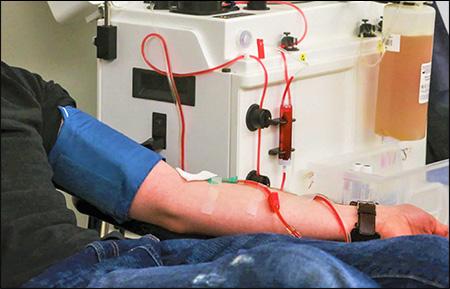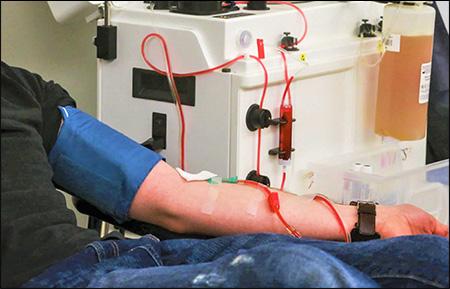Hemapheresis is a process in which blood parts or blood components are removed by automated equipment. This process is very safe, in which plasma and platelets are removed from blood and the left part is sent back to the donor's body. The donor should be ABO and Rh typing and must meet the criteria applicable as the donor for normal donation. All the process is based on the centrifugation principle. The Whole process takes two hours to complete. In this article we will discuss this process in detail and its alternative in Ayurveda.

Introduction
This process has been used widely in clinical practice for removal of toxins from the blood. It includes cell depletion in which removal of platelets, red cells and leukocytes from the patient's circulation. This process is also called therapeutic plasma exchange. It can be used in various diseases such as thrombocytosis, malaria, leukocytosis, aplastic anaemia and many other blood related disorders. In ayurveda it can be correlated with raktamokshan and raktshodhan in which toxins from the blood are removed. Various methods used in this therapy are leech therapy, shrunga, alabu and sirovedha. In case of raktshodhan various herbs used in the purification of blood are manjistha, sariva, haridra, guduchi and neem. Let's discuss in detail.
Process of Hemapheresis
Therapeutic plasma exchange is a process in which toxins are removed from blood by automated equipment. This is a highly advanced technique in which exchange, replace, or at least manipulate particular cellular or blood constituents in a broad panel of different diseases. Firstly blood is taken from donors through a needle after that it is mixed with anticoagulants and separated in separators. All this activity works on the centrifugation method.
The Components of Blood Which Involves in this Process are:-
- Plasmapheresis
- Plateletpheresis
- Leukapheresis
- Stem cell harvesting
- Donors hemapheresis
1. Plasmapheresis
In this plasma is removed from the blood that helps to reduce circulating antibodies and other complexes.
2. Plateletpheresis
In this condition platelet count is very high so platelets can be removed to avoid complications of thrombosis and bleeding.
3. Leukapheresis
If the patient is suffering from thrombosis then WBC are removed from the patient's body.
4. Stem Cell Harvesting
In this stem cells can be harvested using the transplantation procedures.
5. Donors Hemapheresis
The process of hemapheresis is becoming popular day by day because in this process a person can donate blood to others.
Indicators of Hemapheresis
- Wilson disease
- Thrombocytosis
- Systemic lupus erythematosus
- Sickle cell disease
- Myasthenia gravis
- Multiple sclerosis
- Malaria
- Lung transplantation
- Liver transplantation
- Kidney transplantation
- Inflammatory bowel disease
- Immune thrombocytopenic purpura
- Leukocytosis
- Hemolytic uremic syndrome
- Hemolytic disease of foetus
- Familial cholesterolemia
- Dermatomyositis
- Dilated cardiomyopathy
- Coagulation factor inhibitors
- Burn with circulatory shock
- Aplastic anaemia
- Autoimmune hemolytic anaemia
- Age related macular degeneration
- Systemic amyloidosis
- Amyotrophic lateral sclerosis
- Acute liver failure
Ayurvedic Overview
According to ayurveda this process can be correlated with raktamokshan because in this procedure just like hemapheresis toxins are removed from the blood. According to acharya sushruta, rakta is considered as a fourth dosha. When the doshas are in normal limits maintain well being but when they aggravate or lower then causes many health problems. According to ayurveda when doshas are aggravated in blood then they cause blood disorders. In ayurveda these can be correlated with rakta pradoshaj vikara. Various rakt pradosha vikara are as follows:-
- Pleeha
- Mashaka
- Asya paka
- Vidradhi
- Kamala
- Neelika
- Charamdala
- Shvitra
- Pama
- Dadru
- Visarpa
- Vyanga
- Tilkalka
- Kotha
- Vatashonita
- Arsha
- Angamarda
- Indralupta
- Arbuda
- Medhra paka
- Guda paka
- Asru Dhara
- Kushth
- raktapitta
Now, we will discuss raktamokshan in detail.
Raktmokshan
It is a procedure in which toxins are removed from the blood by various methods. It is of two types:-
1. Shastra
It is a procedure in which sharp instruments are used. Prachana and siravedha are its types.
2. Anushastra
It is a procedure in which blood is let out without any instruments. In this jalauka, shrunga and alabu are mainly used
Indications
- Swelling
- Gonorrhea
- Headache
- Burning sensation
- Sinusitis
- Conjunctivitis
- Heaviness of body
- Debility
- Mastitis
- Tumour
- Fibroid
- Elephantiasis
- Skin disease
- Rashes
- Swelling
Contraindications
- Haemorrhoids
- Anaemia
- Pregnancy
- Emaciated persson
- Anasarca
Samyak Lakshan
- Cheerfulness of mind
- Severity of disease
- Subsiding of pain
- Feeling of lightness of body
Atiyog Lakshans
- Deep puncturing
- Puncturing in hot season
- During excess sweating
Season for Raktmokshan
Autumn season is the best season for raktmokshan
Various methods of raktamokshan are as follows:-
1. Leech Therapy (Jalokavcharana)
Leeches are mainly found in water and in cold places. This therapy is considered very easy for removal of toxins from the blood. In this therapy non poisonous leeches are mainly used.
Types of Leech
There are two types of leech
- Poisonous leech
- Non-poisonous leech
1.Poisonous Leech
They are called savish jaloka and is of six types- Krishna
- Karbura
- Alagarda
- Saamudrika
- Indra-yudha
- Go chandana
2. Non - Poisonous Leech
They are called nirvish jaloka and of six types- Kapila
- Pingala
- shankh - mukhi
- Mushika
- Pundarika- mukhi
- Saavarika
Method of Application of Jaloka
First of all, the affected part is washed properly with an antiseptic solution. Then leech is applied to the affected area. When leech starts sucking the blood then it is covered with moist cloth. When it completes sucking the blood then turmeric powder is used to stop the bleeding.
1. Shrunga
This is the best method for removal of toxins from the blood and mainly used in vata dushti. In this method cow's horn is used for blood letting. Cow's horn should be open at both ends. In this method small incisions are made over the affected part. The larger part of the cow's horn is kept over the incised area.
2. Alabu
In this method pitcher guard is used for bloodletting and this process is mainly used in kapha dushti. In this method firstly the pitcher is opened at the top. All the seeds and pulp are removed from the top of the pitcher guard. The length of alabu should be 12 angul. After that it is dried under the sun till it is hard. In this affected part should be cleared with antiseptic solution and multiple incisions made over the site.
3. Siravedha
In this procedure a tourniquet is applied above the selected area. When the vein is prominent then it is punctured using a sharp needle. After the complete blood flow, the affected area is tightly bandaged to stop bleeding.
Raktashodhana
In this therapy blood can be purified by herbal medications. As we have studied that hemapheresis separates toxins and other unwanted components from the blood. Just like hemapheresis there are some herbs that purifies the blood such as manjishtha ( Rubia cordifolia), sariva ( Hemidesmus indicus), haridra ( Curcuma longa), neem ( Azadirachta indica) and guduchi ( Tinospora cordifolia). Let's discuss in detail
1. Manjishtha
Manjistha ( Rubia cordifolia) is a natural herb that is found in India. It shows various properties such as anti-inflammatory, antipyretic, antiprotozoal, leprosy healing and wound healing etc. As we know leprosy is caused by vitiated blood and can be managed by raktshodhan. It works on the brain and is helpful in the management of stress and anxiety. Herb paste can be applied directly to the affected parts in case of skin disorders, ulcers and inflammation. It is also useful in increasing menstrual flow and purifies breast milk. So we can say that it is the best herb for purification of blood.
2. Sariva
Sariva ( Hemidesmus indicus) is a herb that grows everywhere in india. It mainly balances the three doshas. It is very helpful in increasing fertility. It shows antiinflammatory properties and also purifies the blood. So it can be used in blood related disorders such as soft chancre, chronic rheumatoid arthritis and gout etc. This herb is also useful for rejuvenating the skin.
3. Haridra
Haridra ( Curcuma longa) is a herb that is usually grown all over India but mainly in Tamil naidu, Mumbai and Bengal. It balances the three doshas and is helpful in the management of various disorders such as syphilis and herpes. This herb is mainly used to boost immunity and fight against various disorders. It has antioxidant properties which is very helpful in the proper functioning of blood elements. It is also helpful in pittaja disorders.
4. Guduchi
Guduchi ( Tinospora cordifolia) is found everywhere in India. This herb is very useful in boosting the immunity and also purifying the blood. It is also useful in the management of skin related disorders. This herb is used to maintain the health of the skin, lungs and immune system. Respiratory tract disorders are also manageable by this herb. Guduchi is also helpful in the management of dysentry, diarrhoea, skin disorders, urine disorders, dyspepsia, jaundice and diabetes.
5. Neem
Neem ( Azadirachta indica) is a wonderful herb used in the purification of blood. The main property of this herb is to remove toxins from the blood. It shows amazing results in skin related diseases such as acne, itching etc. it also regulates blood circulation and shows best results in all blood related disorders.
Contact Planet Ayurveda Support Team to provide you the costing/ordering and delivery information at - [email protected] or Call at 0172-521-4040 (India), +91-172-521-4040 (Outside India) or Whatsapp at (+91) 842-749-4030.
Conclusion
Hemapheresis is a process in which blood parts or blood components are removed by automated equipment. It is also called therapeutic plasma exchange. This process is very safe, in which plasma and platelets are removed by blood and the left part is sent back to the donor's body. All the process is based on the centrifugation principle. In ayurveda it can be correlated with raktamokshan and raktshodhan in which toxins from the blood are removed. Various methods used in this therapy are leech therapy, shrunga, alabu and sirovedha. In case of raktshodhan various herbs used in the purification of blood are manjistha, sariva, haridra, guduchi and neem. Here in this article we have discussed hemapheresis in detail and its ayurvedic correlation also.
Dr. Vikram Chauhan (MD - Ayurveda) is the CEO and Founder of Planet Ayurveda Pvt. Ltd. He is Author of the Book "Ayurveda - God's Manual For Healing". He is an Ayurveda Expert Serving People worldwide through all the Possible Mediums, Operating from Main Branch in Mohali, India. With his Vast Experience in Herbs and their Applied Uses, he is successfully treating Numerous Patients suffering from Various Ailments with the help of Purest Herbal Supplements, Diet, and Lifestyle, according to the Principles of Ayurveda. For More Details, visit www.PlanetAyurveda.com.
View more posts from this author
- Plasmapheresis
- Plateletpheresis
- Leukapheresis
- Stem cell harvesting
- Donors hemapheresis
- Wilson disease
- Thrombocytosis
- Systemic lupus erythematosus
- Sickle cell disease
- Myasthenia gravis
- Multiple sclerosis
- Malaria
- Lung transplantation
- Liver transplantation
- Kidney transplantation
- Inflammatory bowel disease
- Immune thrombocytopenic purpura
- Leukocytosis
- Hemolytic uremic syndrome
- Hemolytic disease of foetus
- Familial cholesterolemia
- Dermatomyositis
- Dilated cardiomyopathy
- Coagulation factor inhibitors
- Burn with circulatory shock
- Aplastic anaemia
- Autoimmune hemolytic anaemia
- Age related macular degeneration
- Systemic amyloidosis
- Amyotrophic lateral sclerosis
- Acute liver failure
- Haemorrhoids
- Anaemia
- Pregnancy
- Emaciated persson
- Anasarca
- Cheerfulness of mind
- Severity of disease
- Subsiding of pain
- Feeling of lightness of body
- Deep puncturing
- Puncturing in hot season
- During excess sweating
- Poisonous leech
- Non-poisonous leech

